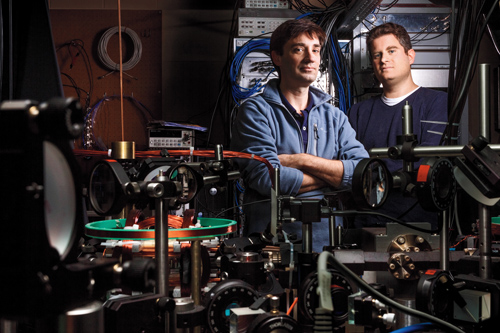By Caroline J. Hanna
In an unprecedented achievement, Amherst physicists have created a synthetic magnet with a single pole.
[Physics] Like other magnets large and small, a refrigerator magnet has a north and south pole. Break it in half and you get two magnets, each with its own north and south pole. While scientists have long searched for a magnetic monopole—a magnet with a single pole—no one’s ever found such a particle in nature.
Now, more than 80 years after physicist Paul Dirac predicted its existence, scientists at Amherst have created, identified and photographed a synthetic analogue of the magnetic monopole for the first time ever. This paves the way for the detection of the elusive particles in nature, which would be a revolutionary development comparable to the discovery of the electron.

Professor David Hall (left) and Postdoctoral Research Associate Michael Ray. Photo by Rob Mattson.
The lab finding is the result of a collaboration led by Professor of Physics David Hall ’91 and Aalto University (Finland) Academy Research Fellow Mikko Möttönen. The experiments took place in an atomic refrigerator built by Hall and his students in his basement lab in the Merrill Science Center.
“The creation of a synthetic magnetic monopole should provide us with unprecedented insight into aspects of the natural magnetic monopole—if indeed it exists,” says Hall.
In January Nature published a paper about the work, co-authored by Hall, Möttönen, Amherst Postdoctoral Research Associate Michael Ray, Saugat Kandel ’12 and Finnish graduate student Emmi Ruokokoski. “To be able to confirm the work of one of the most famous physicists,” says Ray, the paper’s lead author, “is probably a once-in-a-lifetime opportunity.”
As the name suggests, a magnetic monopole is a magnetic particle possessing a north pole without a south pole, or vice versa. In 1931 Dirac published a paper that explored the nature of monopoles in the context of quantum mechanics. But despite extensive experimental searches since then, in everything from lunar samples (moon rocks) to ancient fossilized minerals, no observation of a naturally occurring magnetic monopole has been confirmed.

These diagrams show the synthesis of a monopole in time, starting with panel A and ending with panel C. The arrows mark the direction of the magnetic field produced in the Hall lab. The magnetic field directs the spin of Bose–Einstein condensate in the direction of the arrows. The condensate begins to move as if it were electrically charged and affected by a magnetic monopole in the position marked by the black circles.
Hall’s team created synthetic monopoles in an artificial magnetic field generated by a Bose-Einstein condensate—a gas only tens of billionths of a degree warmer than absolute zero. The team relied upon theoretical work published by Möttönen and his student Ville Pietilä that suggested a particular sequence of changing external magnetic fields could lead to the creation of the synthetic monopole.
Ultimately, the Merrill experiments yielded photographs confirming the monopoles’ presence at the ends of tiny quantum whirlpools within the ultra-cold gas. This proves experimentally that Dirac’s envisioned structures can exist in nature.
Hall says the project arose out of interest from Amherst student researchers in 2011, well after Pietilä and Möttönen’s 2009 paper appeared in Physical Review Letters.
“It felt as though Pietilä and Möttönen had written their letter with our apparatus in mind, so it was natural to write them with our questions,” says Hall. “Were it not for the initial curiosity on the part of the students, we would never have embarked on this project.”